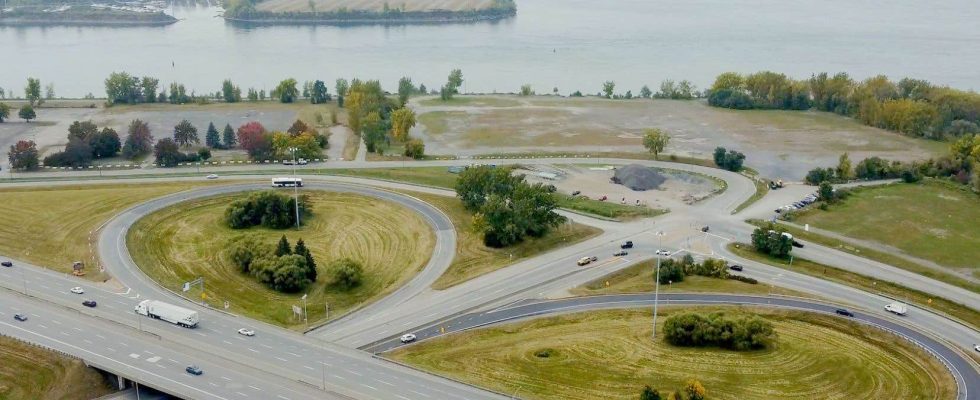The project has been described as a future “Brooklyn of the North.” An important step has just been taken towards the development of a new “model” district along the river on the South Shore, near the Longueuil–Université-de-Sherbrooke metro station.
Depending on what The duty has learned, the City of Longueuil and the Canada Lands Company (CIS) have signed a five-year agreement aimed at preparing the ground to erect between 3,500 and 4,000 housing units in this area offering direct access to the St. Lawrence — and a view privileged in Montreal.
Access to the banks will remain public. A riverside promenade will run along the river, according to the letter of intent which was to be ratified Tuesday evening by the Longueuil municipal council. The concept submitted by the SIC also provides for the construction of residential and commercial buildings, parks, public squares as well as new traffic and access routes to the site.
“This is an important milestone that confirms our intention to collaborate with the Canada Lands Company [pour ce projet immobilier] », indicates to the Duty Catherine Fournier, mayor of Longueuil.
She is delighted that the federal body has confirmed its desire to “prioritize Longueuil” among its potential projects in the Montreal region. This new district will be built on a vast vacant lot which mainly belongs to the Canadian government.
On foot, by bus, by bike
This district will be established on a strip of land located between Highway 132 and the river, behind the quadrilateral that houses the Longueuil–Université-de-Sherbrooke metro station. The City plans to build a footbridge for pedestrians and cyclists above the highway, between the metro and the new real estate development, specifies the mayor.
“We want it to be a model district in terms of sustainable mobility. Travel on foot, by bike and by public transport are at the heart of the project,” explains Catherine Fournier.
Tens of thousands of cars will continue to circulate every day on the expressways which surround the Longueuil metro quadrilateral, particularly towards the Jacques-Cartier Bridge located right next to it.
However, the City intends to ensure that lanes reserved for buses will be created in the area even before the construction of the buildings. A series of roads will be redeveloped. Two new access ramps to the site will be built. Discussions are planned with the Ministry of Transport and Sustainable Mobility, which is responsible for Route 132 and its ramps.
Access to the future district by public transport, on foot or by bike is considered essential, because the rate of private parking offered in this new district will be relatively low compared to current standards, explains the mayor. Technical studies reveal that the depth of underground parking lots will have to be limited due to the proximity of the river, according to her.
Reflection for a school
To avoid repeating the error made in the creation of Griffintown, in the southwest of Montreal, the City of Longueuil and the SIC are committed to quickly assessing the needs for a school and a daycare service.
Catherine Fournier is calling on the Ministry of Education to relax the standards dictating school architecture: given that space is limited, she wants the future primary school to be built high up and to have play areas for children. children are provided on each floor or on the roof of the building, for example.
She visited a five- or six-story school in Copenhagen, Denmark, where each grade level had its own floor with a recess terrace. “It’s not a school with a playground like ours, but the children seemed happy,” says the mayor.
Affordable housing
The City of Longueuil and the SIC also agree that the project must allow the creation of a “socially and economically diverse neighborhood, in particular through the insertion of social and affordable housing”. Catherine Fournier wants land to be reserved to allow non-profit groups to build social housing.
The SIC specifies Duty that its guidelines provide for at least 20% social or affordable housing in all its real estate projects in Canada.
“We feel that the mayor and her team want to move the project forward quickly,” rejoices Marcelo G. Wiuckstern, spokesperson for the SIC.
Catherine Fournier envisages the presence of several types of buildings, and not only high-rise towers, like those being built above the metro station and elsewhere in the future “downtown” of Longueuil. “We don’t want to create a barrier of towers. The notion of landscape is important in the project,” she summarizes.
The agreement confirms the partners’ desire to see the neighborhood created “in the near future”. The mayor wants the project to be launched within five years. If necessary, the letter of intent between the City and CLC can be extended for another period of five years. It will first be necessary to carry out three studies — on mobility in the sector, on the banks and on wildlife.
